This Statement of intent (SoI) sets out an approach and course of action for the next three years that will contribute to the delivery of the government's land transport objectives and wider transport vision. It includes performance measures and what is intended to be measured (and how) and details of what is expected to be accomplished. The document also includes full financial statements. The SoI is a statutory compliance document.
Download the complete report:
NZ Transport Agency Statement of intent 2013–2016 [PDF, 1.5 MB]
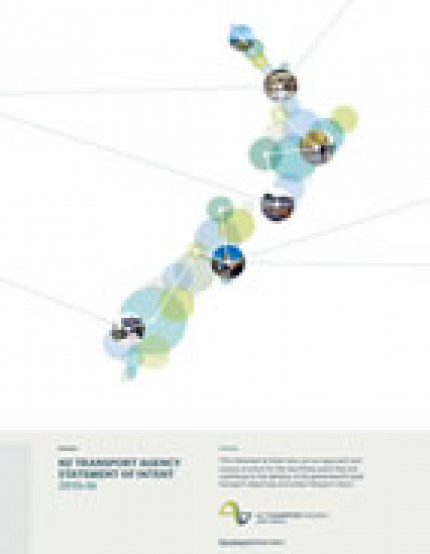
| Previous page | Table of contents |
This section provides explanation and technical details for non-financial performance measures. These notes are presented by goal and include goal progress indicators, priority indicators, investment service indicators and result performance measures.
Goal progress indicators
Efficient and reliable movement of freight
The % of travel by HPMVs of total heavy vehicle VKT demonstrates the percentage of travel by high productivity motor vehicles (HPMV) of the total kilometres travelled by heavy vehicles. This indicator presents the volume of higher productivity motor vehicle freight kilometres. An increase in HPMV kilometres travelled will realise increase freight efficiency as fewer truck trips are undertaken but at higher loads. This increased efficiency will help deliver on NZTA’s priority of moving more freight on fewer trucks and subsequently lift the transport sectors productivity.
Efficient and reliable movement of people
Network productivity: speed and flow on Auckland urban network. This indicator measures lane capacity utilisation (network productivity) of the urban network. Productivity is measured in terms of the product of speed and flow compared to road lane optimal vehicle throughput. It demonstrates how effectively the current road network and operational management activities handles peak demand for vehicle movement. This indicator provides information to help deliver on the NZTA’s priority of making the most of urban network capacity.
Optimal range of travel and transport choices
The % of survey respondents that consider public transport as a good option for taking some or all of their work or study trips in Auckland. This indicator demonstrates the perceived attractiveness of alternative travel choices available to the public. It is a lead indicator for public transport passenger boardings.
Statement of service performance measures
Management of the funding allocation system
1. The total cost of the management of the funding allocation system is the NZTA service delivery cost for this output less the cost of taxi enforcement activity and crash analysis system (CAS) business activities which are not part of the management funding allocation system.
2. The % of operational assurance activities completed is an aggregate of three specific dimensions: lessons learned, audits and post-implementation review programmes. Operational assurance activities are assessed according to their effectiveness, economic efficiency and strategic fit (ie high, medium, low). Aggregation is based on the weighted volume of activity in the given year.
3. The % of activities that are delivered to agreed standards and timeframes is an aggregate of four specific measures to monitor the quality and efficiency of managing NLTP expenditure and forecast standards, including investment approval and decision activities. All components of the measure have targets of 100%. Aggregation to the overall result is based on weighted volume of activity across the components in the given year.
4. The average number of days taken to deliver is determined by how long it takes, on average, to process and approve funding of a new NLTP activity. Days to funding approval is defined as the number of working days between the date of receipt to the date the approval was recorded in the transport information online system.
5. The % customer satisfaction demonstrates the percentage of approved organisations’ stakeholders (regional, local and unitary authorities, Department of Conservation, Auckland Transport Agency and the Waitangi National Trust) that were satisfied with the relationship between their organisation and the NZTA. This is measured through an independently conducted survey.
Transport planning
6. The % of activities that are delivered to agreed standards and timeframes includes transport planning, studies, strategies and models and activity management planning activities. These components are individually assessed against targets of >90%. Aggregation of these results is based on the weighted volume of activity for each area. The NZTA works collaboratively with its local authority partners as they prepare strategies, plans and packages to help ensure that when they are formally received they are of high quality, meet the NZTA assessment criteria and are therefore suitable for support or endorsement by the NZTA. It provides an indication of how well the NZTA manages its transport planning activities to time and cost standards.
Sector research
7. The % of activities that are delivered to agreed standards and timeframes is a measure that compares planned time, cost and quality of research investment with actual performance. All aspects have targets of 100% and contribute equally to the overall result. It is a measure of the effectiveness of the NZTA as a programme manager.
Goal progress indicators
Safe speeds: The number of deaths and serious injuries on open roads (80–100km/h).This indicator focuses on the high proportion of road deaths (70–80%) that take place on open roads. This indicator shows progress on NZTA’s priority of ensuring safe speeds on the roads to reduce deaths and serious injuries.
Using roads safely: The number of deaths and serious injuries in alcohol/ drug related crashes. This indicator focuses on the involvement of alcohol/ drugs as a contributing factor in contributing to fatal and serious injuries.
Using safer vehicles: This aspect is measured by the % of new vehicles with five-star safety rating. This indicator reflects the impact that structural changes in the vehicle fleet have on road safety. An increasing proportion of new cars with a five star safety rating will, over time, have a positive impact on the number and severity of injuries suffered by individuals.
Making efficient use of vehicles: The efficient use of vehicles is measured by the average petrol and diesel consumption (litres) per 100 vehicle kilometres travelled. This indicator reflects changes in the fuel efficiency of the new, more efficient, vehicle fleet.
Statement of service performance measures
Licensing and regulatory compliance
8. Unit transaction cost measures the direct unit cost of delivering a driver licence/driver testing transaction/service.
9. The % of transactions completed online is the proportion of practical test bookings completed through the NZTA website divided by the total number of test bookings completed for motor vehicle and motorcycle licences.
10. The % accuracy of registers is a measure of the data input accuracy of the driver licence register (DLR) based on monthly audit checks from a random sample of 100 callers and a selection of agents’ work processed against what’s written on the form and recorded in DLR. The measure reflects the average of the audit results.
11. The % of operational assurance activities completed is an aggregate of three specific operational assurance activities (eg audits) of driver testing agents, transport operators, and certifying agents completed against planned. Aggregation is based on the weighted volume of activity in the given year.
12. The % of activities that are delivered to agreed standards and timeframes is an aggregate of six specific dimensions – four audit activities of driver testing agent officers and course providers, transport operators, certifying agents and regulatory compliance and agent service delivery (with targets of >90%); and two completion rates against standard of official correspondence and transport rules development programmes (with targets of 100%).
Aggregation to the overall result is based on weighted volume of activity across the components in the given year.
13. The number of products and delivered or processed include new and renewed driver licences, issuing of driver and transport operator testing services, certification review, border inspection, over dimension permits and drug and alcohol assessments funded.
14. The % customer satisfaction reflects the proportion of licensing customers who considered it easy to complete their driver licensing test booking via the internet. It is sourced from a feedback survey open to all users of the internet transaction service.
Road tolling
15. Unit transaction cost is the direct unit cost of delivering a toll service. Cost excludes write offs, bad debts and administration fees from toll payment notices.
16. The % of transactions completed online is the proportion of casual trip payments and toll payment notice (TPN) transactions completed through the internet over the total number of trip and TPN payments. Toll payment notices are issued to customers who have not paid their toll fees within 5 days.
Motor vehicle registry
17. The % of transactions completed online is the proportion of motor vehicle annual licensing (new and renewals) purchased over the internet, direct connect and via an industry agent divided by the total number of motor vehicle registrations.
18. The % accuracy of register reflects the accuracy of the information entered into the motor vehicle registry (MVR). Data verification activities are focused on confirming vehicle attributes; vehicle ownership and address information in the MVR. It combines the result of regular audit checks by regional staff, unverified owner and address information returns.
19. The % customer satisfaction reflects the proportion motor vehicle register customers who consider the internet transaction they undertook was easy to complete. It is sourced from a feedback survey open to all users of the online transaction service. Responses are based on the following online transactions – vehicle licence renewal, bought or sold a vehicle, a registered person or stolen vehicle check, an exemption from vehicle licensing, applying for registered person name and address and revoking access to personal details.
Road user charges (RUC) collection, investigation and enforcement
20. The % of transactions completed online is the proportion of light and heavy vehicle RUC licence purchased online over the total number of RUC licences purchased. Online refers to transactions via Direct Connect, Transact, e-RUC and automatic tellers.
21. The number of products/services delivered or processed includes light and heavy vehicle RUC license purchases and off road RUC rebate claims. This is an aggregate figure showing a total of assessment, enforcement and refund activities.
Refund of fuel excise duty (FED)
22. Average number of days taken to deliver is determined by how long it takes, on average, to process and approve FED refunds. Days to deliver refer to the number of working days between the date of application to the date of approval recorded in the FED database system.
23. The number of products/services delivered or processed is the number of FED refund applications processed or delivered for the reporting period. The volume of application is based on the processing date.
Goal indicators
Safe highway journeys: Safe highway journeys are measured by the number of deaths and serious injuries in head-on and run-off road crashes on state highways. This indicator reflects that road design can have considerable impact on these types of crashes.
Efficient and reliable highway journeys: Efficient and reliable highway journeys are measured by the number of resolved road closures with a duration of 12 hours or longer. This indicator reflects responsiveness to any unplanned closures that occur on the state highway network. This responsiveness ensures that disruption to the reliability and efficiency of the network is minimised.
Social and environmentally responsible highways: The provision of socially and environmentally responsible highways is measured by the % compliance with state highway consent conditions. This indicator reflects the desire to minimise social and environmental impacts through our activities on the state highway network by complying with resource consent conditions. The measure includes conditions relating to environmental permits in resource consents, designations, Department of Conservation concessions, Historic Places Trust authorities and building consents as recorded in NZTA's consent compliance management system.
Statement of service performance measures
New and improved infrastructure for state highways
24. % of activities that are delivered to agreed standards and timeframes compares time, cost and quality of large, block and property acquisition programmes (at the time that construction commenced). It is a measure of the effectiveness of the NZTA as a project manager. Within each programme, time, cost and quality are equally weighted with targets of >90%. Aggregation to the overall result is based on weighted programme expenditure across the components in the given year. Construction of passing opportunities on State Highway 2 between Napier and Gisborne: The % of activities that are delivered to agreed standards and timeframes is based on the proportion of the fund spent according to scope and Vote Transport for new and improved state highway work on Buckle Street in Wellington and on passing lanes between Napier and Gisborne.
25. The % of customers’ satisfaction demonstrates the percentage of supplier stakeholders that were satisfied with the relationship between their organisation and the NZTA. This is measured through an independently conducted survey.
Renewal of state highways
26. The % of activities that are delivered to agreed standards and timeframes presents the physical achievement of renewal activities and progress of state highway pavement renewal programme against baseline. It is a measure to keep track of the delivery of physical performance targets. The single component aspect of this measure examines the proportion of state highway renewal work completed compared to the planned kilometres.
27. Safe stopping: % of travel on network above skid threshold reflects efficiency in meeting surface texture standards (to ensure safe stopping) as per sector research. Minimum acceptable levels of skid resistance are set in relation to the road environment. The annual programme of reseals (surface renewals) is driven (in part) by the need to improve skid resistance.
28. Network resilience: % of rutting >20mm over state highway network is the proportion of rutting above the 20mm threshold over the length of the state highway network. Rutting in the road surface (long shallow channels generally found in wheelpaths) is one of the key indicators of the health of the underlying pavement and the need for pavement renewal. Ruts often also hold water and thus lower skid resistance.
Maintenance and operation of state highways
29. The % of activities that are delivered to agreed standards and timeframes presents the physical achievement of maintenance activities and progress of state highway maintenance programme against baseline. It is a measure to keep track of the delivery of physical performance targets. The single component aspect of this measure examines contracts terminated for non-performance of agreed contractual obligations.
30. Safe stopping: % of travel on network above skid threshold reflects efficiency in meeting surface texture standards (to ensure safe stopping) as per sector research. Maintenance of the state highway focuses on ensuring skid resistance (to ensure safe stopping). Minimum acceptable levels of skid resistant are set in relation to the road environment. The annual programme of reseals (surface renewals) is driven (in part) by the need to maintain network skid resistance.
31. Smooth ride: % of travel on network classed as smooth is the proportion of travel (proportion of vehicles kilometres travelled on the network surveyed) that occurs on pavements smoother than a nominated surface texture standard over the length of the network surveyed.
32. % availability of state highway network. It is expressed as the sum of all unscheduled road closure incidences (both urban and rural) which have a significant impact on road users addressed within standard timeframes (ie urban < 2 hours; rural < 12 hours) and protocol over the total number of road closure incidences.
33. The % customer satisfaction reflects the proportion of the public who are satisfied with the availability of network information and the overall rating of the state highways in New Zealand. It is sourced from several customer surveys. These are computer aided telephone interviewing (CATI) design survey with quotas set for target audiences according to age, race, sex and residential region (prescribed numbers are set for each to ensure balance and fairness).
Priority indicators
Efficient road maintenance investment & delivery: Efficient road maintenance investment is measured by the programmed savings in maintenance and operations activity in 2012-15 National Land Transport Programme. This indicator reflects the need to pursue greater value for money in a constrained funding environment. Efficient road maintenance investment and delivery is a NZTA priority for the next three years.
Statement of service performance measures
Administration of the SuperGold cardholders’ scheme
34. The % of activities that are delivered to agreed standards and timeframes is a measure of our speed of processing and approving SuperGold claims to regional councils. The component measure is the average number of days taken to process claims received from regional councils. Days to process is defined as the difference between the date the payment was made and the date the claim was submitted/recorded in the Transport Information Online (TIO) or Land Transport Programme (LTP) website by the regional council (RC). Claims are received, validated and paid electronically.
Road safety promotion
35. The % of activities that are delivered to agreed standards and timeframes is a measure of timeliness and effectiveness in delivering road safety education, advertising and promotion. Components of this measure look at the percentage of the road safety education and advertising campaigns completed on time and the percentage of education and promotion programmes that meet forecast participation rates. All components have a 100% target and contribute equally to the overall result.
36. % of target audience aware of road user safety messages is a measure based on a computer aided telephone interviewing (CATI) design survey with quotas set for target audiences according to age, race, sex and residential region (prescribed numbers are set for each to ensure balance and fairness). It is currently limited to advertising and television. The scope to include other communication media such as print, web (eg YouTube) and phone (eg Twitter) is currently being considered.
Statement of service performance measures
New Zealand Transport Ticketing Limited (NZTTL) central systems operations
37. The % of activities that are delivered to agreed standards and timeframes is a measure of NZTTL to deliver the project within agreed budget and timeframes. Refer page 91 for description of NZTTL’s activities.
The following sections detail the key progress indicators for the NZTA goals. The NZTA seeks to deliver desired results for all of our key progress indicators. For the Statement of intent 2013-16 we intend to focus on 5 priorities – Safe speeds to reduce deaths and serious injuries, moving more freight on fewer trucks, making the most of urban network capacity, efficient road maintenance investment and delivery, and putting customers at the heart of our business. For each of our strategic priorities we have set ourselves challenging three-year stretch targets.
Efficient & reliable movement of freight
Percentage of travel by HPMVs of total heavy vehicle VKT
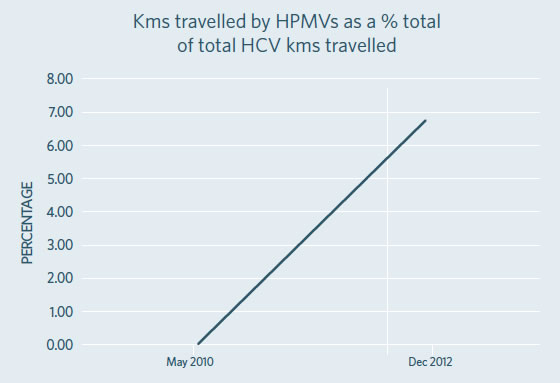
Optimal range of travel and transport choices
Percentage of survey respondents that consider public transport as a good option for taking some or all of their work or study trips in Auckland
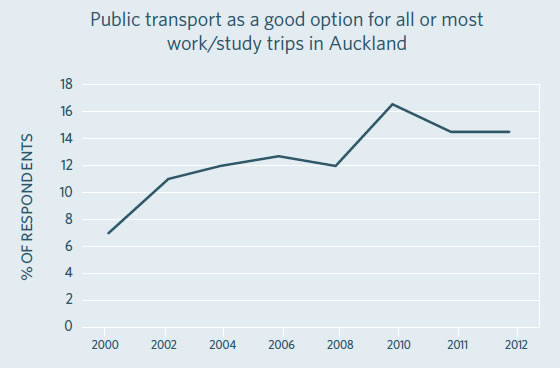
Safe speeds
Deaths and serious injuries on undivided open roads (80-100km/h)

Using roads safely
Deaths and serious injuries in alcohol/drug related crashes
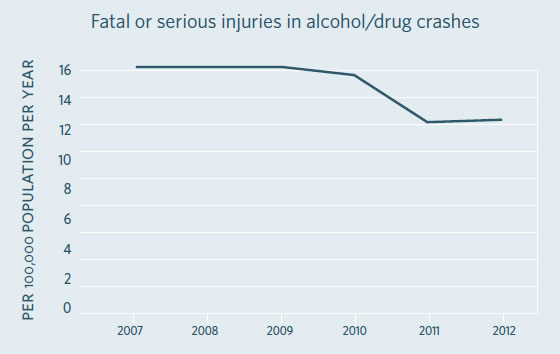
Using safer vehicles
Percentage of new vehicles with five star safety rating
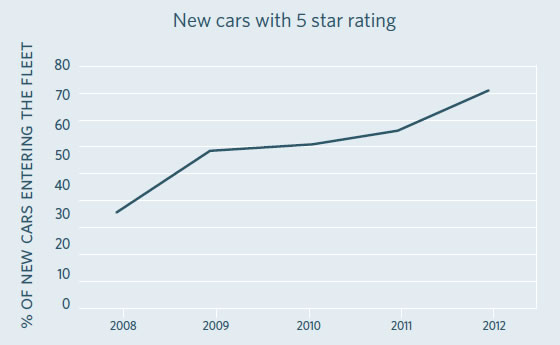
Making efficient use of vehicles
Average petrol and diesel consumption (litres) per 100 vehicle kilometres travelled
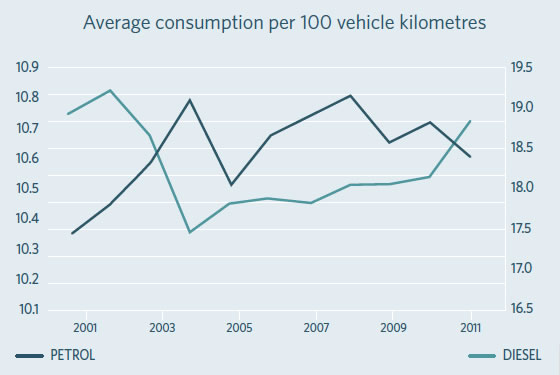
Safe highway journeys
Number of deaths and serious injuries in head-on and run-off road crashes

Efficient & reliable highway journeys
Number of resolved road closures with a duration of 12 hours or longer

Social & environmentally responsible highways
Percentage compliance with state highway consent conditions

| Previous page | Table of contents |